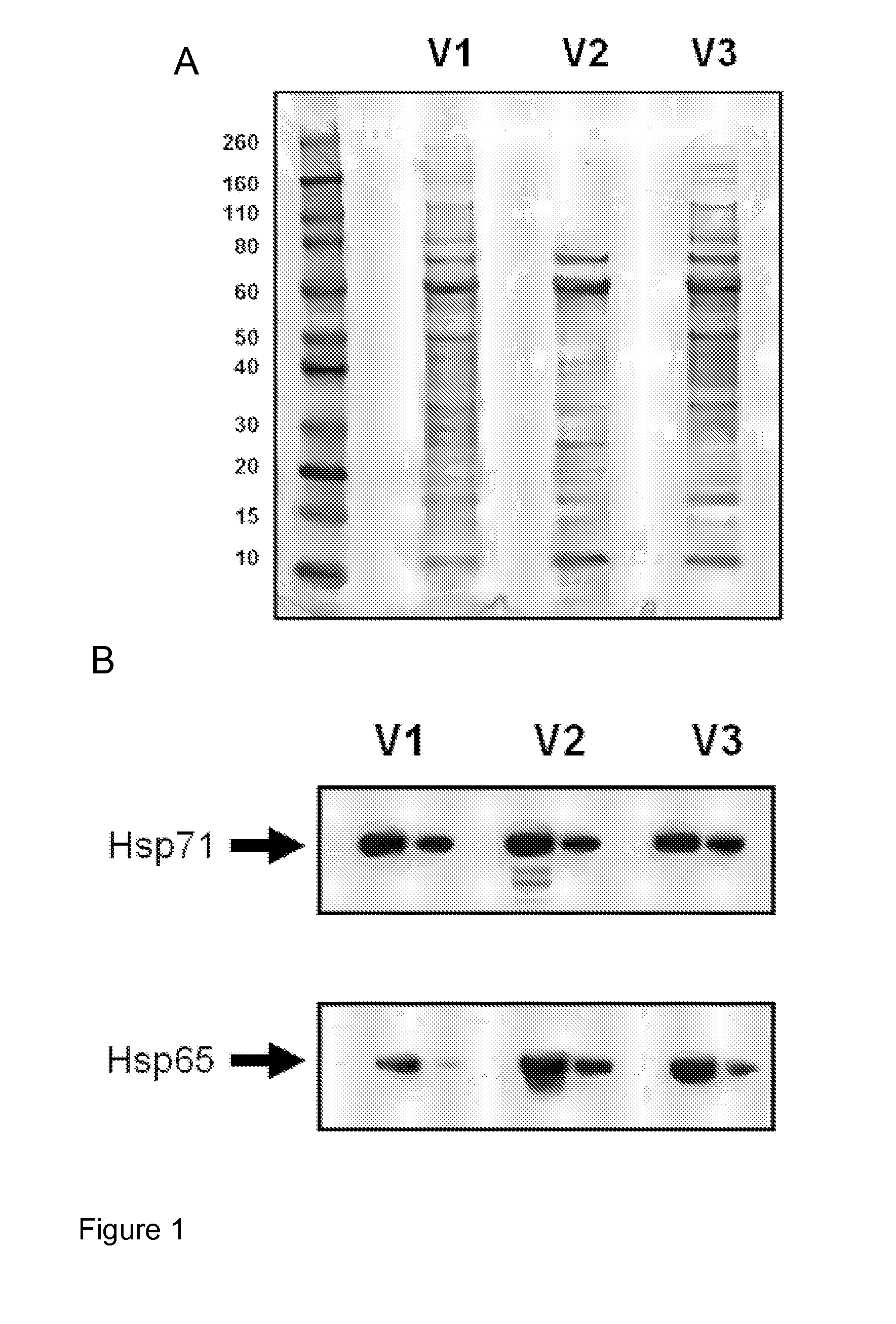Method for the purification of protein complexes
- Summary
- Abstract
- Description
- Claims
- Application Information
AI Technical Summary
Benefits of technology
Problems solved by technology
Method used
Image
Examples
example 1
Preparation of HspC-Enriched Preparations from BCG Cellular Lysates
[0149]BCG cell pellets from mid-log heat shocked cultures were lysed and clarified by centrifugation. Cell pellets were resuspended in sterile PBS containing an EDTA-free protease inhibitor cocktail. Resuspended cells were lysed using sonication, a Beadbeater or passed through an Emulsiflex C5 high pressure homogeniser and collected in a sterile bag. Benzonase (250 U / mL) was added to the lysate. The samples were then homogenised a further two times, the cellular lysate transferred to centrifuge tubes and cell debris removed by centrifugation for 20 minutes at 6000 g. The clarified lysate was collected and centrifuged for a further 60 minutes at 14000 g and the supernatant was removed and referenced as high speed clarified lysates. 10 ml of clarified lysates were desalted and buffer exchanged into 50 mM phosphate buffer pH 6.8. The protein concentration of the sample was determined and an IEC (ion exchange chromatogra...
example 2
Enhancing Complex Stability in the Preparation of HspC-Enriched Preparations from BCG Cellular Lysates
[0150]BCG cell pellets from mid-log heat shocked cultures were lysed and clarified by centrifugation. Cell pellets were resuspended in sterile PBS containing an EDTA-free protease inhibitor cocktail. Resuspended cells were lysed using sonication, a Beadbeater or passed through a Emulsiflex C5 high pressure homogeniser and collected in a sterile bag. Benzonase (250 U / mL) was added to the lysate. The samples were then homogenised a further two times, the cellular lysate transferred to centrifuge tubes and cell debris removed by centrifugation for 20 minutes at 6000 g. The clarified lysate was collected and centrifuged for a further 60 minutes at 14000 g and the supernatant was removed and referenced as high speed clarified lysates. 10 ml of clarified lysates were desalted and buffer exchanged into 50 mM HEPES, 1 mM MgCl2, pH 6.8 with or without 1 mM ADP. The HspC enriched preparation ...
example 3
Immunogenicity of BCG Derived HspC-Enriched Preparations
[0151]BCG HEPs were used to immunise BalbC mice and spleens harvested from the immunised animals 28 days after immunisation. Spleens were collected into RPMI-1640 and single cell suspensions were made by pressing the spleens through 70 μm cell strainers using a 5 mL syringe plunger into a 50 mL Falcon tube. Cells were counted using trypan blue exclusion on a KOVA glasstic slide haemocytometer and the production of interferon gamma (IFN-γ) assayed in a recall response to TB antigens.
[0152]2×106 splenocytes were added to each well in a 24 well tissue culture plate (Nunc) in 1 mL culture medium and to each well, one of the following antigens was added: BSA (10 μg / ml), Con A (10 μg / ml), TB whole cell lysate (WCL at 50 to 1.56 μg / mL), HEPs, IEF HspCs or Ag85 (10 μg / mL).
[0153]Culture supernatants from the re-stimulated wells were tested for IFN-γ IL-2, IL-4 and IL-5 using a murine ELISA kit according to the manufacturer's protocol (R...
PUM
| Property | Measurement | Unit |
|---|---|---|
| Molar density | aaaaa | aaaaa |
| Molar density | aaaaa | aaaaa |
| Power | aaaaa | aaaaa |
Abstract
Description
Claims
Application Information
 Login to View More
Login to View More - R&D
- Intellectual Property
- Life Sciences
- Materials
- Tech Scout
- Unparalleled Data Quality
- Higher Quality Content
- 60% Fewer Hallucinations
Browse by: Latest US Patents, China's latest patents, Technical Efficacy Thesaurus, Application Domain, Technology Topic, Popular Technical Reports.
© 2025 PatSnap. All rights reserved.Legal|Privacy policy|Modern Slavery Act Transparency Statement|Sitemap|About US| Contact US: help@patsnap.com



